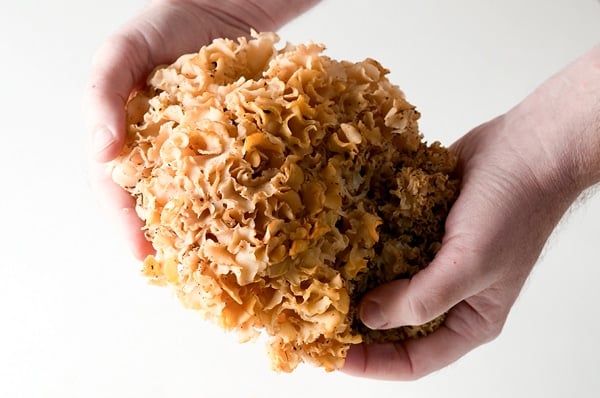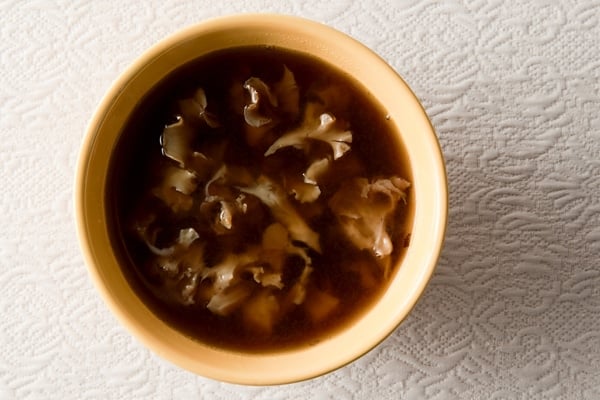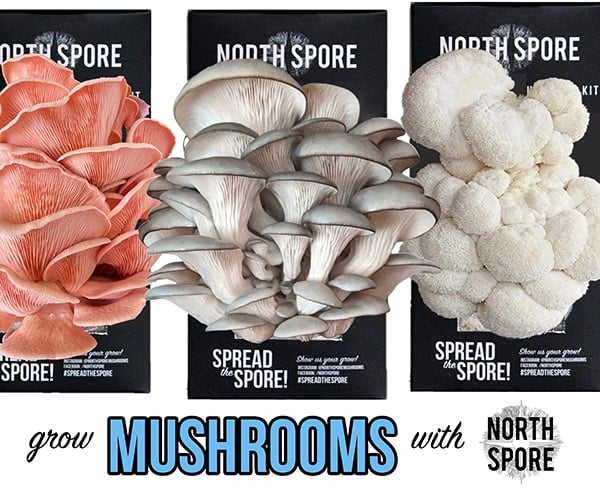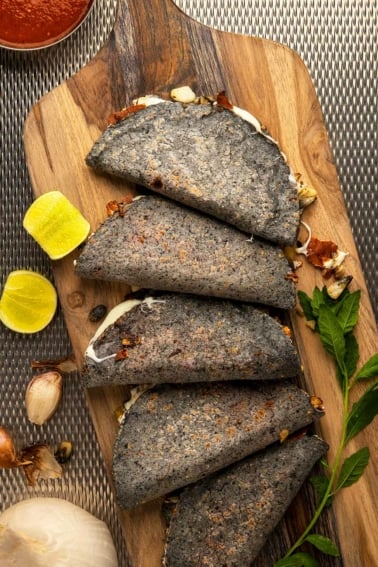Sparassis, the Elusive Cauliflower Mushroom
February 27, 2014 | Updated January 15, 2024
As an Amazon Associate I earn from qualifying purchases.

Sparassis. Cauliflower mushroom. Queen of the forest. A one-mushroom party. Big, easy to identify, delicious. What’s not to love?
If this sounds too good to be true, it is. The cauliflower mushroom, as S. crispa is commonly called out here, is devilishly hard to find. I’ve walked whole seasons here in California without finding one. But walk you must, because this mushroom is a loner.
The silver lining is that cauliflower mushrooms come up in the same spot year after year, so mark your GPS or mental map. Also mark your calendar because you won’t want to miss your chance.
The sparassis I am holding in the picture above is half of one my friend Eric and I found on California’s North Coast. I’ve returned to this spot several times this season, but our drought had been so severe I thought I might never see it again. Thankfully we’re now getting some serious rain, so I can only hope to see it sprout soon.
Typically cauliflower mushrooms pop between December and early March here in California. It’s a bit earlier in the Pacific Northwest; my friend Langdon Cook tends to find them in October and November up in Washington. There is an Eastern variety of sparassis, too: S. spathulata, that you can find as early as July and as late as October. You can find a variety of sparassis in Europe, too.
That’s the when. The “where” is at the base of a tree. Sparassis is a saprobe, a parasite that leeches off particular kinds of trees. In the West it will be pines — mine’s under a Bishop pine — and in the East look at the base of hardwoods. The mushroom seems to prefer older trees that are a little beat down; my sparassis is under a pine with a trunk about two feet wide with a bunch of storm-broken limbs.
What you’re looking for is a large, ivory-to-yellow clump. How large? A gigantic one can weigh a full 100 pounds, but most are between a pound and 10 pounds. They burst up from under the pine duff and really shine in a dark wood.
Identification is super easy. Langdon has the best analogy: Imagine a big batch of egg noodles that you left in a colander overnight. That is exactly what a sparassis looks like. There are no poisonous look-similars.
Cut the mushroom at the ground level and shake it upside down to dislodge random pine needles, woodland creatures and whatnot. Take it home and refrigerate it for up to a week, covered in a paper towel or cloth in a plastic container. The edges will yellow as the cauliflower mushroom ages, but it will still be OK.

Once you are ready to cook your sparassis, you will need to grab your favorite adult beverage and get to cleaning. All those folds trap ungodly amounts of debris — and gird your loins for millipedes and earwigs leaping out at you. How do I do it? I cut the mushroom into chunks and dunk them into a big bowl of cold water. Cauliflower mushrooms don’t absorb a lot of moisture easily, so fear not. Slice off any gnarly looking bits and lay the good pieces on a cloth to dry.
How to cook them? Cauliflower mushroom is the ultimate soup mushroom. It’s essentially a cross between an al dente egg noodle and a mushroom. It has a mild flavor a lot like a morel mushroom that happens to go very well with red meats.

Lang likes it with beef pot roast, but he also pickles them. A lot of people will sauté them like any other mushroom, but I think they need some time to cook properly. (If you get more than you can eat in a few days, my advice is to cook them first, then freeze.)
Looking for more info about finding and cooking wild mushrooms? I have a huge selection of mushroom recipes here.






I found a nice one in my front yard underneath my hugh rododendron bush im surprised the chickens didn’t eat it the are always under there. None under the 23 other rododendrons in the yard. Lol it is elusive.
Had never seen one, but lo and behold one popped up here in n.c. in an urban patch of woods. Used to hunt chantrelles when I lived in big sur, but this type is of mushroom totally surprised me. Amazing!
We hunt for Morels out of Dayton, WA and find the cauliflower mushroom also, they look more like a broccoli florets
We have had really good luck finding patches of cauliflower mushrooms while searching for morels. We hunt outside of Pendleton, Oregon. We have found pounds of morels, and cauliflower mushrooms. We have been drying them so they don’t go bad. I haven’t cooked with the cauliflower mushrooms, so really appreciate the ideas. Great website!
Biggest one I found barely fit in a 33gallon trash bag.
The funniest thing was it grew on the 2 hour drive home.
It was raining when I found it
Today I just came across one on my walk in the Yucatan jungle just a few yards from my home along the road. Glad to know that there is no look-similar mushroom that is either toxic or just non-edible. Soaking now to remove all the other creatures that got there before me. First time have come across one of these anywhere. Most shrooming done in San Francisco Bay Area. Not much listing that I can find about Mexico in general and the Yucatan jungle in particular. Hope I survive.
I just found my first cauliflower in the Skokomish Valley of Washington. I’m going to try a method I heard about – to break it up in small pieces, spread out on a cookie sheet and drizzle with oil, a dry seasoning (optional), salt and pepper and either bake at high heat or broil until crispy like potatoes chips.
I’m still laughing/smiling about the cauliflower I stumbled across yesterday somewhere in the Hamma-Hamma River valley. About the size of two basketballs side by side. For those outside the Pacific N.W., we are blessed with some huge fir stumps still standing from decades past logging. That’s where I find about 9 out of 10 cauliflowers. And it’s amazing how many are on the other side of stump. So, unless you “circle the stump…”???
Have been keeping records for the past 3-5 years on cauliflowers and so far have not found one fruiting on stump/tree where it was originially cut. I keep hearing about the “go back next year and harvest theory…” but am still waiting. Any thoughts? The one thing I haven’t done is leave one untouched and monitor for a few years. Do they always fruit each season?
Tonights soup of cauliflower/chanterelles and a fresh loaf of Irish soda bread is one of many reasons we love the rain…
Wishing you a smile and a laugh when you “circle that stump” and…!!!
Lovley article, I just found one in the south of England (Dartmoor, Devon). My first time. I washed and sliced mine then fried with some olive oil butter salt and pepper and felt so lucky to have this delight, gift. I like the look of your recipe though!
Mine was only half a pound, maybe next year I will monitor it to hope to gain more and allow the mushroom to live longer. Just about to roast some sweet chestnut followed by a hearty handful of Liberty Liberty (little magics, a dance with shanti sheeva). Bless Gav
here in the Czech Republic we also make a soup out of it – called “mock tripe soup” if literally translated –
found this video guide to the recipe – except that the recipe in english should specify caraway. not cumin (although you can use either, the flavour will of course be different)- personally, i also add some spicy paprika and some fresh garlic (but that is up to personal taste)
My wife and I have a fave ‘shroom place here in WA, at a park near the Hood Canal. Normally it is the place we find edibles like White & Yellow Chanterelles, Hedgehogs, Boletes, Angel Wings, Oysters, and Lobsters, as well as an assortment of many other non-edibles I like to take pictures of. In the last two years we have found Cauliflower Mushroom.
The first year I yanked a large Cauliflower ‘shroom off a large Doug Fir stump….mistake. You should ALWAYS cut it off at the base so it can regrow (for several years I have come to understand). This year I found another at a different place, so I did the correct procedure while gathering it up. It was a much smaller one this time, but now that I’ve followed proper procedure I will be back next year to get an even bigger one (I hope). We are anxious to try out some new recipes w/this delectable…used it in a shrimp & sliced sea scallop fettucine last time…’twas outstanding!!!
So…Bony Appetites (my way of French) to all. Nothing like fungi to make one’s day!!!!
A friend of mine just found a ten pounder here in South Bend, In, in the same spot he looks every year. I’m excited to go on the hunt for my own tonight!
in Eastern Oregon they are very common even in groups of Three or four with in Five feet. my grandma always canned them for soup etc. it is easier to clean then in a big tub of water when you first get home with salt. the bugs crawl out. then rinse
I too have a coveted tree that I’ve returned to repeatedly in order to harvest this mushroom. Mine is mere steps off a well trodden path around the backside of the tree. My favorite way to prepare this is to make a simple bisque. And I do mean simple.
I saute it in butter with a little garlic and onion, then simmer it in fresh raw goat milk, adding a little homemade chicken stock if necessary. Once it’s thickening nicely I put about half of it in the blender to make it nice and smooth, and then return it to the remaining bisque. A little sea salt and fresh ground pepper to taste completes the simple dish.
I’ve never felt the need to add herbs or other flavorings, but I suppose you could.
Was looking for some new recipe ideas for my next, hoped-for find of cauliflower mushrooms. Soup it is!
I also find under Doug Fir. Another great identifying feature is the awesome scent of apricots.
Just had a huge downpour here in sac valley, can’t wait to go looking for some. No bishop pines around, I will try foothill pines. Thanks for the great article.
What’s the main flavor profile of this mushroom? Is it similar to maitake?
I’m in San Diego, I’ll be looking at pine trees in a whole new way!
We occasionally find them here in WA. Made Phad Thai with it once, worked out great!
Here in Portugal I find them every year. I have some spots memorized where they appear in the autumn. I love them, specially in soups. If you want I can send you the recipe I use although its very similar to the one you use (broth with the mushrooms inside – the only difference is that I blitz the toughest parts of the mushroom with an immersion blender to rev up the mushroom taste, and leave the tender fronds intact)